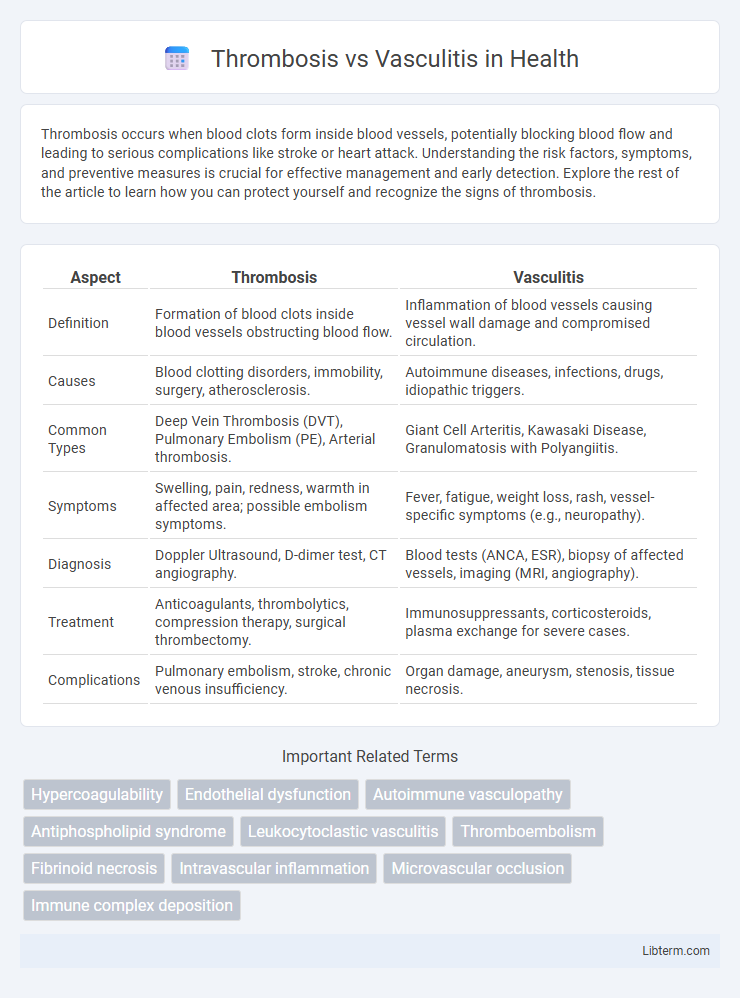Thrombosis occurs when blood clots form inside blood vessels, potentially blocking blood flow and leading to serious complications like stroke or heart attack. Understanding the risk factors, symptoms, and preventive measures is crucial for effective management and early detection. Explore the rest of the article to learn how you can protect yourself and recognize the signs of thrombosis.
Table of Comparison
| Aspect | Thrombosis | Vasculitis |
|---|---|---|
| Definition | Formation of blood clots inside blood vessels obstructing blood flow. | Inflammation of blood vessels causing vessel wall damage and compromised circulation. |
| Causes | Blood clotting disorders, immobility, surgery, atherosclerosis. | Autoimmune diseases, infections, drugs, idiopathic triggers. |
| Common Types | Deep Vein Thrombosis (DVT), Pulmonary Embolism (PE), Arterial thrombosis. | Giant Cell Arteritis, Kawasaki Disease, Granulomatosis with Polyangiitis. |
| Symptoms | Swelling, pain, redness, warmth in affected area; possible embolism symptoms. | Fever, fatigue, weight loss, rash, vessel-specific symptoms (e.g., neuropathy). |
| Diagnosis | Doppler Ultrasound, D-dimer test, CT angiography. | Blood tests (ANCA, ESR), biopsy of affected vessels, imaging (MRI, angiography). |
| Treatment | Anticoagulants, thrombolytics, compression therapy, surgical thrombectomy. | Immunosuppressants, corticosteroids, plasma exchange for severe cases. |
| Complications | Pulmonary embolism, stroke, chronic venous insufficiency. | Organ damage, aneurysm, stenosis, tissue necrosis. |
Introduction to Thrombosis and Vasculitis
Thrombosis involves the formation of blood clots within blood vessels, leading to vascular obstruction and potential tissue damage. Vasculitis refers to the inflammation of blood vessel walls, causing vessel narrowing, weakening, or rupture. Both conditions disrupt normal blood flow but differ in pathophysiology, with thrombosis primarily related to clot formation and vasculitis to immune-mediated vascular inflammation.
Definitions: Thrombosis vs Vasculitis
Thrombosis is the formation of a blood clot inside a blood vessel, obstructing the flow of blood through the circulatory system. Vasculitis refers to the inflammation of blood vessels, which can cause changes in the vessel walls, including thickening, weakening, narrowing, or scarring. Both conditions affect vascular health but involve different underlying pathological processes--thrombosis centers on clot formation, while vasculitis involves immune-mediated inflammation.
Underlying Causes and Risk Factors
Thrombosis primarily results from factors that disrupt normal blood flow or increase blood coagulability, such as prolonged immobility, genetic clotting disorders, and endothelial injury. Vasculitis, by contrast, is caused by autoimmune reactions, infections, or drug-induced inflammation targeting blood vessel walls. Risk factors for thrombosis include obesity, smoking, and advanced age, while vasculitis is commonly associated with autoimmune diseases like lupus and rheumatoid arthritis.
Pathophysiological Differences
Thrombosis involves the formation of a blood clot within a blood vessel, leading to obstruction of blood flow primarily due to hypercoagulability, endothelial injury, or stasis. Vasculitis is characterized by inflammation and necrosis of blood vessel walls, resulting from immune-mediated responses that cause vessel wall damage and compromise vascular integrity. While thrombosis primarily disrupts blood flow by occlusion, vasculitis involves direct inflammation-induced injury to the vessel structure, often triggering secondary thrombotic events.
Clinical Manifestations and Symptoms
Thrombosis presents clinically with localized pain, swelling, redness, and warmth due to vessel obstruction causing impaired blood flow, often seen in deep vein thrombosis with calf tenderness and edema. Vasculitis symptoms vary by vessel size and location but typically include systemic signs like fever, fatigue, weight loss, along with organ-specific manifestations such as skin rashes, neuropathy, or glomerulonephritis from immune-mediated vessel inflammation. Differentiation hinges on thrombosis-related ischemic signs versus vasculitis-related inflammatory and constitutional symptoms, necessitating targeted diagnostic evaluation.
Diagnostic Approaches and Biomarkers
Thrombosis diagnosis relies heavily on imaging techniques such as Doppler ultrasound and CT angiography to detect vascular occlusion, supported by blood tests measuring D-dimer levels and coagulation profiles. Vasculitis diagnosis involves tissue biopsy for histopathological evaluation and serological markers including antineutrophil cytoplasmic antibodies (ANCA) and elevated inflammatory markers like ESR and CRP. Biomarker analysis in thrombosis centers on coagulation factors and platelet function, while in vasculitis, immune-mediated markers and cytokine profiles provide critical diagnostic insights.
Imaging and Laboratory Findings
Thrombosis typically presents on imaging as vessel occlusion or filling defects in ultrasound Doppler, CT angiography, or MRI, with laboratory findings showing elevated D-dimer and possible markers of hypercoagulability. Vasculitis reveals vessel wall thickening, edema, and contrast enhancement on MRI or CT angiography, while lab tests often demonstrate elevated inflammatory markers such as ESR and CRP, along with specific autoantibodies depending on the vasculitis type. Differentiating features include the presence of thrombus without significant vessel wall inflammation in thrombosis versus inflammatory vessel wall changes and systemic inflammatory response in vasculitis.
Treatment Strategies and Management
Treatment of thrombosis primarily involves anticoagulants like heparin and warfarin to prevent clot formation and thrombolytics for clot dissolution, while vasculitis management focuses on immunosuppressive agents such as corticosteroids and cyclophosphamide to control inflammation. Addressing underlying causes, monitoring for complications, and tailoring therapy based on disease severity are critical in both conditions. Long-term management requires regular imaging and laboratory tests to assess treatment efficacy and prevent recurrence.
Complications and Prognosis
Thrombosis can lead to severe complications such as stroke, myocardial infarction, and deep vein thrombosis, often resulting in tissue ischemia and necrosis with a variable prognosis depending on prompt anticoagulant treatment. Vasculitis causes vessel wall inflammation that may result in aneurysms, organ ischemia, or chronic organ damage, with prognosis heavily reliant on the specific type of vasculitis and response to immunosuppressive therapy. Both conditions pose risks for permanent organ dysfunction, but early diagnosis and tailored management significantly improve outcomes.
Prevention and Lifestyle Modifications
Preventing thrombosis involves maintaining a healthy weight, engaging in regular physical activity, and avoiding prolonged immobility to improve blood flow and reduce clot risk. Vasculitis prevention centers on controlling underlying autoimmune conditions, managing inflammation through a balanced diet rich in antioxidants, and avoiding infections that may trigger immune responses. Both conditions benefit from smoking cessation, stress management, and routine medical check-ups to monitor vascular health and implement early interventions.
Thrombosis Infographic

 libterm.com
libterm.com